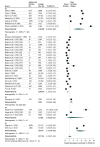Global Prevalence and Incidence of Tinnitus: A Systematic Review and Meta-analysis
- PMID: 35939312
- PMCID: PMC9361184
- DOI: 10.1001/jamaneurol.2022.2189
Global Prevalence and Incidence of Tinnitus: A Systematic Review and Meta-analysis
Erratum in
-
Error in Open Access Status.JAMA Neurol. 2023 Feb 1;80(2):216. doi: 10.1001/jamaneurol.2022.4248. JAMA Neurol. 2023. PMID: 36342699 Free PMC article. No abstract available.
Abstract
Importance: To date, no systematic review has taken a meta-analytic approach to estimating the prevalence and incidence of tinnitus in the general population.
Objective: To provide frequency estimates of tinnitus worldwide.
Data sources: An umbrella review followed by a traditional systematic review was performed by searching PubMed-MEDLINE and Embase from inception through November 19, 2021.
Study selection: Research data from the general population were selected, and studies based on patients or on subgroups of the population with selected lifestyle habits were excluded. No restrictions were applied according to date, age, sex, and country.
Data extraction and synthesis: Relevant extracted information included type of study, time and location, end point, population characteristics, and tinnitus definition. The study followed the Meta-analysis of Observational Studies in Epidemiology (MOOSE) reporting guideline.
Main outcomes and measures: Pooled prevalence estimates of any tinnitus, severe tinnitus, chronic tinnitus, and diagnosed tinnitus as well as incidence of tinnitus were obtained using random-effects meta-analytic models; heterogeneity between studies was controlled using the χ2 test, and inconsistency was measured using the I2 statistic.
Results: Among 767 publications, 113 eligible articles published between 1972 and 2021 were identified, and prevalence estimates from 83 articles and incidence estimates from 12 articles were extracted. The pooled prevalence of any tinnitus among adults was 14.4% (95% CI, 12.6%-16.5%) and ranged from 4.1% (95% CI, 3.7%-4.4%) to 37.2% (95% CI, 34.6%-39.9%). Prevalence estimates did not significantly differ by sex (14.1% [95% CI, 11.6%-17.0%] among male individuals; 13.1% [95% CI, 10.5%-16.2%] among female individuals), but increased prevalence was associated with age (9.7% [95% CI, 7.4%-12.5%] among adults aged 18-44 years; 13.7% [95% CI, 11.0%-17.0%] among those aged 45-64 years; and 23.6% [95% CI, 19.4%-28.5%] among those aged ≥65 years; P < .001 among age groups). The pooled prevalence of severe tinnitus was 2.3% (95% CI, 1.7%-3.1%), ranging from 0.5% (95% CI, 0.3%-0.7%) to 12.6% (95% CI, 11.1%-14.1%). The pooled prevalence of chronic tinnitus was 9.8% (95% CI, 4.7%-19.3%) and the pooled prevalence of diagnosed tinnitus was 3.4% (95% CI, 2.1%-5.5%). The pooled incidence rate of any tinnitus was 1164 per 100 000 person-years (95% CI, 479-2828 per 100 000 person-years).
Conclusions and relevance: Despite the substantial heterogeneity among studies, this comprehensive systematic review on the prevalence and incidence of tinnitus suggests that tinnitus affects more than 740 million adults globally and is perceived as a major problem by more than 120 million people, mostly aged 65 years or older. Health policy makers should consider the global burden of tinnitus, and greater effort should be devoted to boost research on tinnitus.
Conflict of interest statement
Figures


References
Publication types
MeSH terms
LinkOut - more resources
Full Text Sources
Medical

